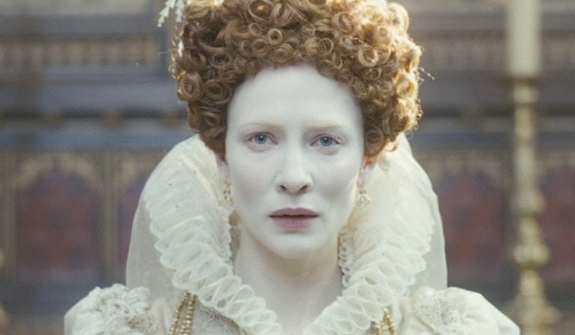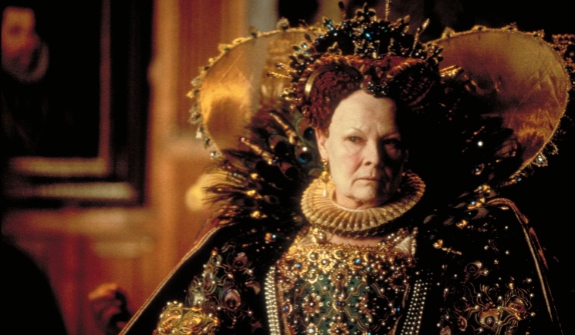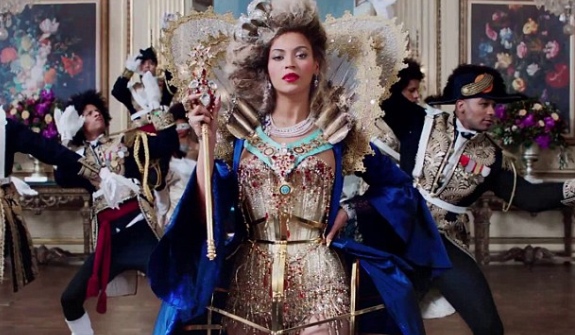
At the end of Shekhar Kapur’s Elizabeth (1997), Cate Blanchett’s face finally transforms into the portraiture that we firmly associate with this famous Queen of England. The face that is adorned with an ivory mask of white make-up and framed by the waves of her majesty’s hair, pinned up by pearls. At this moment in Kapur’s film, Elizabeth I is no longer the vulnerable flesh and blood woman we have watched throughout the film—she is now an icon. That this moment hinges on emphasizing the Queen’s striking visage—a thing of alabaster and stone—foregrounds the ways in which Elizabeth I (also dubbed the Virgin Queen) has become deeply embedded within a feminist film aesthetic that is, and always will be, a specific formulation of camp.
Kapur’s emphasis on Elizabeth’s dependence on artifice and the exaggerated, gendered performance of her role calls to mind Susan Sontag’s reflection on camp representation, especially her comments on the significance of exaggeration itself:
The hallmark of Camp is the spirit of extravagance. Camp is a woman walking around in a
dress made of three million feathers. Camp is the paintings of Carlo Crivelli, with their real
jewels and trompe-l’oeil insects and cracks in the masonry.
Of all the representations of Elizabeth on film, it is Kapur’s that most radically situates Elizabeth within both a feminist and performative context. That is, as a woman performing an accentuated version of femininity, and also as a camp icon whose very existence depends on an extravagant staging of artifice, ornately embellished from ear to foot. At the end of the film, Blanchett becomes the iconic Queen, but in making this transformation apparent—in making her artifice visible—Kapur resolutely frames Elizabeth within a camp context. Both real and unreal, girl and Queen, goddess and imperfect human, much like those jewels that call into relief the “cracks in the masonry” of Crivelli’s art.
Yet, there is also a camp pleasure to be found in the earlier images of the Queen before this dramatic finale. There is something deliciously camp about the sight of Blanchett as the young Elizabeth: her heavily stylised twirling, girlish dance in the sunlight at the beginning of the film before she is crowned Queen; tableaus in which monochromatic light changes Blanchett into a silvery goddess as a storm descends on the palace. Pleasure abounds. On an aesthetic level, the formal sensibility of these scenes are highly suggestive of a certain kind of camp iconography. Elizabeth is ethereal as she dances in the grass near Hatfield and is spectacular as her ladies-in-waiting of the castle dress her.[i]
While Kapur’s film highlights the camp sensibility of Elizabeth I, he is not the first. This historical figure has been frequently co-opted as a conduit for camp provocation, as well as for feminist and queer subversions. Most notable is Quentin Crisp’s performance as Elizabeth in Sally Potter’s Orlando (1992), which not only articulates Virginia Woolf’s critique of gendered identity from the book on which the film is based, but also transforms Elizabeth into a postmodern, camp icon.

Like Blanchett, Crisp best channels Elizabeth as a camp screen persona when occupying the frame as a still and embellished object within the often portrait-like mise en scène. Crisp, a casting triumph for Potter, becomes Elizabeth through the armoury of her clothing. In an interview with The New York Times, he discussed robing as a rigorous process:
First around my waist, two rolls of fabric were tied with tapes. Then came a hooped skirt,
then a quilted petticoat, then an ordinary petticoat and finally, a dress. On my upper half,
I wore a bejewelled bodice so tight that it blistered my stomach.
Crisp’s costumes are even more dense and structured than Blanchett’s, and were constructed in ways that transform his physicality into newly shaped angles and proportions. (In this regard, the costumes were closer to performance art than film spectacle in how they took a physical toll on Crisp’s body.) Potter’s version of Elizabeth I offers a finely nuanced exploration of camp through Crisp’s performance, which plays on our foreknowledge of Crisp’s real-life persona as an eccentric gay writer known for his tousled hair and painted nails. Potter brilliantly subverts and re-affirms Crisp’s identity via the elaborate artifice that is Elizabeth’s corsetry and make-up in a way that is apt and uncanny. He acquires a different alchemy, a different economy of power and beauty—one that transcends the limits of his body or Elizabeth’s (quite literally in the case of his blistered stomach).

Then there’s Judi Dench’s Oscar-winning performance in Shakespeare in Love (John Madden, 1997), which affirms and gives rare status to the aging female star’s body. The diminutive Dench is suddenly much more visible in Elizabeth’s stiff, sepulchral skirts and the bodices that glint and dangle with jewels. Her powdered face accentuates the soft lines around her mouth and her fire-bright eyes. Here, Dench’s body is a site of camp excess that also bears feminist implications. While Crisp’s performance as Elizabeth highlighted the ways gender can be performed as a set of gestures and shapes (the skirt, the bodice), Dench’s Elizabeth is about making her body visible once more after age has determined it redundant (at least by Hollywood standards).

The most recent incarnation of the Queen was in 2013 when Beyoncé channelled Elizabeth in her promotional posters for her Mrs. Carter World Tour—regal, yes, but also highly suggestive and celebratory of her camp persona as the diva known as Queen B. Dressed in shades of gold, blue, and white, Beyoncé wears a hooped, Tudor-style skirt (the infamous undergarment that gave ladies of this era their iconic silhouettes) and a silvery, embellished corset. Her face and shoulders are framed by an open ruff made of golden, embroidered lace, much like the ones Elizabeth I wore herself.
After years of watching Elizabeth on screen, Beyoncé’s tour poster only emphasizes the plurality of this camp icon. Once merely a monarch in a man’s world, now Elizabeth I stands for all things camp, feminist, and transgressive beyond the phallocentric order. In other words, the incarnations of Elizabeth are part of the very fabric of contemporary camp iconography; they represent a definite position with cultural practice and populist aesthetics that destabilizes heteronormative, patriarchal ideology. As history tells us, Elizabeth was a strategist, a politician whose careful manoeuvres resulted in a reign that lasted for over forty years. To this day, her legacy lives on as her elaborate mantle is appropriated by women, men, divas, and dames. That powder on Elizabeth’s face now recalls the settling of dust on all things that burn and ossify in her wake.





